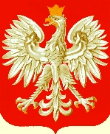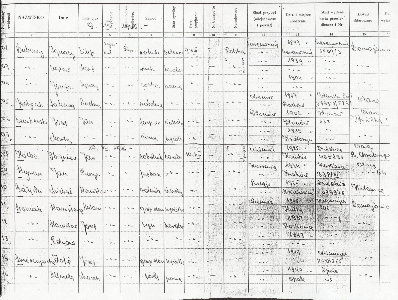The PUR Collection:
|
| Nr. Kolejny ewidencji (sometimes abbreviated as "N", or "Kol." or "L.P." | The Line or Record Number |
| Nazwisko i imię | Surname and First Name |
| Imiona rodziców | Names Of Parents |
| Data urodzenia | Date of Birth |
| Miejsce urodzenia (miejscowość i powiat) | Place of Birth (locality and county). |
| Stan Cywilny | Marriage Status |
| Repatriant lub przesiedleniec | Repatriate or Resettler |
| Narodowość | Nationality |
| Zawód | Occupation |
| Data wyjazdu | Date of Departure |
| Skąd przybył (wieś, powiat)(sometimes listed as Miejsce pobytu w kraju lub zagranicą) | Place of Origin (village, county). |
| Data przybycia or Data przyjazdu | Date of Arrival |
| Dokąd został skierowany (or Dokąd skierowano or simply Dokąd). | Appointed Settlement |
| Data rejestrowania | Date of Registration |
| Skąd wydana karta przesiedleńcza i Nr. | Where was the Resettlement Card issued and Card Number |
Nr. Kolejny ewidencji (sometimes abbreviated as "N", or "Kol." or "L.P."
The Line or Record Number is important if an index is available. In some
cases, I was able to find an index for some counties (powiaty). The index
contains only the name of the head of household. The indexes are grouped
together alphabetically by the first letter of the last name. Within each letter
of the alphabet, the names are not strictly alphabetized. Next to each name is a
number which corresponds to the Line Number in the Registration List.
Nazwisko i imię
Surname and First Name. Although the head of the
household is listed first for each family, surnames differing from the head of
household will be listed. Be aware that the surnames are often spelled
phonetically, and therefore, may be different than what you are familiar with.
Dumanski may have been written as Dómanski.
Frątkiewicz may have been written as Frontkiewicz.
In both these cases, the variations in Polish are pronounced identically.
Sometimes, all children accompanying the head of family were listed. Sometimes, only children above the age of 16 are listed. In such cases, names of children under the age of 16 are not provided, but only a number count of such young children is listed.
Possible Polish terms found in the Lists:
| Ilość czlonków rodziny | Number Of Members In The Family |
| Ilość dzieci do lat 16 | Number of Children up to the age of 16 |
| Ilość dzieci | Number of Children |
Additionally, the relationship of each person to the head of household is often provided. Here are some common Polish vocabulary regarding household relationships:
| babcia | grandmother |
| brat | brother |
| bratanek | nephew, brother’s son |
| bratanica | niece, brother’s daughter |
| bratowa | sister-in-law, brother’s wife |
| ciotka | aunt |
| córka | daughter |
| dziadek | grandfather |
| kuzyn | cousin (male) |
| kuzynka | cousin (female) |
| macocha | stepmother |
| matka | mother |
| mąż | husband |
| ojciec | father |
| ojczym | stepfather |
| pasierb | stepson |
| pasierbica | stepdaughter |
| siostra | sister |
| siostrzenica | niece, sister’s daughter |
| siostrzeniec | nephew, sister’s son |
| stryj | paternal uncle |
| stryjna | aunt on father’s side |
| syn | son |
| synowa | daughter-in-law, son’s wife |
| szwagier | brother-in-law |
| szwagierka | sister-in-law |
| teść | father-in-law |
| teściowa | mother-in-law |
| wdowa | widow |
| wdowiec | widower |
| wnuczka | granddaughter |
| wnuk | grandson |
| wuj | maternal uncle |
| wujna | aunt by marriage, wife of your mother’s brother |
| zięć | son-in-law |
| żona | wife |
Imiona rodziców
Names Of Parents. Sometimes, only the father’s name was listed (in which
case the heading would read
Data urodzenia
Date of Birth. Usually, only the year of birth was listed. This, however, is
obviously in invaluable piece of information that can help distinguish
ancestors. In some rare cases, I did find that a complete date of birth was
provided in the document.
Miejsce urodzenia (miejsco
wość i powiat)Place of Birth (locality and county). Most of the times, only the year would be given for date of birth. However, I have found in some rare cases a full birth date. In some other records, I found only the age of the person given. Fortunately, the names of the villages are usually accompanied by the county in which they existed. This makes searching for specific villages much easier. Keep in mind, however, that there may be a mistake as to listing the correct powiat. In a couple of instances, I found villages listing not the correct powiat, but a neighboring one.
Repatriant lub przesiedleniec
Repatriate or Resettler. This is the status or type of person being
relocated. Repatriate (Repatriant sometimes abbreviated "R" or "Rep.")
is an ethnic Pole who is coming from a region that was Poland before WWII, but
which became the USSR after the war. Resettler (Przesiedleniec, sometimes
abbreviated "P" or "
| Zwolniony z wojska | Discharged from the army |
| Wraca z Niemiec | Returning from Germany |
| Wojskowy | Army/Military |
| Wojsk. | Army |
| Z wojsk. | From the army |
| Powrót z Niemiec | Return from Germany |
| Wrócił z Niemiec | Returned from Germany |
Narodowość
Nationality. This is usually listed as "Polska"
or Polish.
Zawód
Occupation. This lists the occupation of all members in the family.
Data wyjazdu
Date of Departure. This is the date when the person(s) left for the
resettlement.
Skąd przybył (wieś, powiat)
(sometimes listed as Miejsce pobytu w kraju lub zagranicą)
Place of Origin (village, county). This lists the
village, and usually the powiat, from where the person came.
Data przybycia or Data przyjazdu
Date of Arrival. The date when the person arrived, usually by train, to the
relocation point.
Dokąd został skierowany (or Dokąd skierowano or simply Dokąd)
Appointed Settlement. This is the destination of the
person being resettled. The locality will be somewhere in the powiat
of the Assembly Point. Sometimes, a street name was included for larger towns
and cities. Other times, only a general description without a specific place
name was provided, such as "koło Oławy”
(near the city of Oława).
Data rejestrowania
Date of Registration. This is the date that the person registered at the
Assembly Point in the new home in the Western Territories. These Registration
Lists were created as the people were processed. Therefore, you may not find all
members of an extended family together. Furthermore, you will not find all
people traveling from one village together.
Skąd wydana karta przesiedleńcza i Nr.
Where was the Resettlement Card issued and Card Number.
(Sometimes listed as Nr. Ewidencji, Record Number) This is a number on
the person’s resettlement documents. I was not able to locate any of these
documents in the State Archives. At both the
Wrocław and Opole State Archives, I was told that these records were not
preserved. Unfortunately, the people I met in the villages did not keep any such
documents either.
Return to Table of Contents for Repatriation, Resettlement and the PUR Collection
|
www.halgal.com
Questions and Comments to Matthew
Bielawa |



 Many
of the bound books are indexed by the head of the family of the relocating
group. These indexes are not strictly alphabetized, but rather, are kept by the
first letter of the surname. The index was created only using the head of the
family of the relocating group. Not all families were relocated at the same
time. If members of a family traveled separately, the head of each traveling
group would be processed separately in the Registration Lists and thus indexed
separately. Therefore, you may find a father traveling with his children and the
wife traveling separately with some uncles and aunts. In the indexes, you will
find both the father’s name and the mother’s name since they traveled
separately. If, however, they all traveled together, usually the
father’s/husband’s name. The index will list only the first and last name with
the entry number in the actual Registration Lists. This number corresponds to
the line number of a ledger containing all the detailed information about that
person and his/her traveling companions.
Many
of the bound books are indexed by the head of the family of the relocating
group. These indexes are not strictly alphabetized, but rather, are kept by the
first letter of the surname. The index was created only using the head of the
family of the relocating group. Not all families were relocated at the same
time. If members of a family traveled separately, the head of each traveling
group would be processed separately in the Registration Lists and thus indexed
separately. Therefore, you may find a father traveling with his children and the
wife traveling separately with some uncles and aunts. In the indexes, you will
find both the father’s name and the mother’s name since they traveled
separately. If, however, they all traveled together, usually the
father’s/husband’s name. The index will list only the first and last name with
the entry number in the actual Registration Lists. This number corresponds to
the line number of a ledger containing all the detailed information about that
person and his/her traveling companions.